| Posted: April 26, 2012 |
|
'Nano Graveyard' and other amazing nanotechnology images
|
|
(Nanowerk News) Here is another installment of our collection of amazing images from nanotechnology labs from all over the world. You can find other nanotechnology images here.
|
|
Visualization methods provide an important tool in materials science for the analysis and presentation of scientific work. Images can often convey information in a way that tables of data or equations cannot match. Occasionally, scientific images transcend their role as a medium for transmitting information, and contain the aesthetic qualities that transform them into objects of beauty and art.
|
|
As a special feature of recent MRS Meetings, the MRS has offered the popular Science as Art competitions, with entry open to all registered meeting attendees. The images below represent some of the best entries from past meetings. You can see all galleries here on the MRS website: Science as Art
|
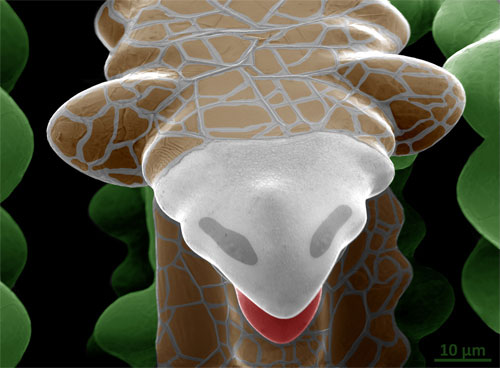 |
| "A dendritic baby giraffe born inside Ni-Ac-C melt. Scanning electron microscopy (SEM) image depicts a baby giraffe formed within a jungle of Ni-Al-C dendrites. As the molten alloy was being solidified inside a graphitic crucible, the melt was decanted, leaving behind a little dendrite wetted by a thin molten blanket. As the jungle got colder, the blanket froze and rejected carbon which eventually crystallized as a graphite cover. Upon further cooling, the graphitic cover wrinkled, due to its thermal expansion coefficient mismatch with metallic substrate, creating a faceted network of creases resembling the familiar skin patches of a giraffe. (Shaahin Amini and Reza Abbaschian, Department of Mechanical Engineering, University of California Riverside)
|
|
|
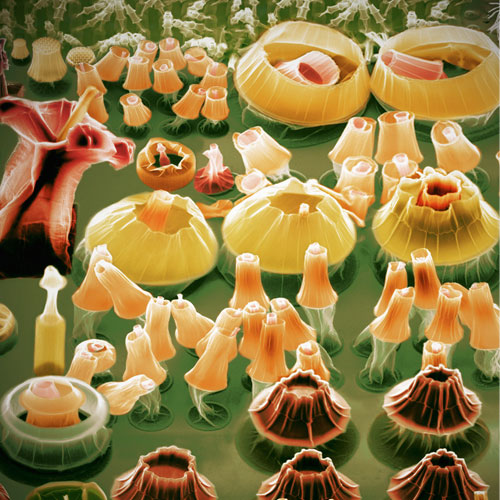 |
| Still life of flowers, mushrooms and other vegetation. Made by capillary self assembly of carbon nanotubes. (M. De Volder, S. Tawfick and A.J. Hart)
|
|
|
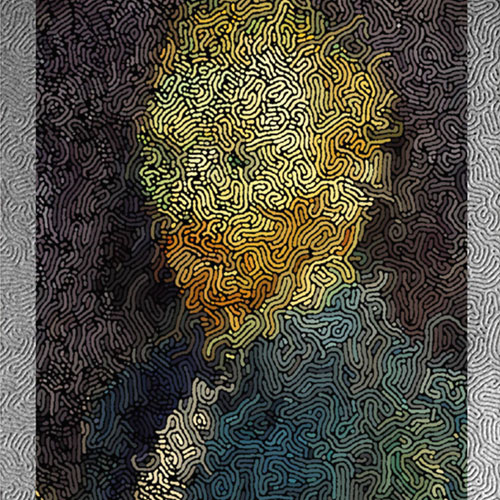 |
| Van Gogh painted with a glassy polymer. Block copolymer lamellae self-assembled in thin films recreate the distinctive brush strokes of Post-Impressionist paintings. (Mark Stoykovich)
|
|
|
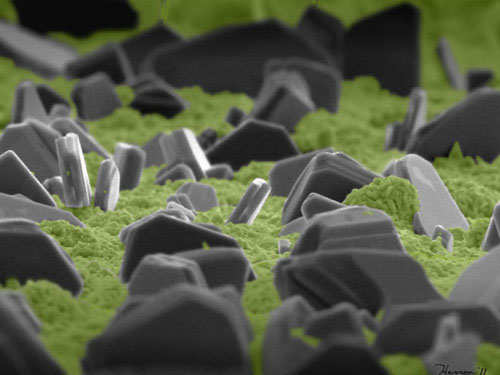 |
| Nano graveyard. The "Nano Graveyard" is a thin film of tin (II) sulfide prepared by a solution method with post-annealing and was imaged using scanning electron microscopy at a low incidence angle. The width of the image covers approximately 10 microns. Part of the film has been artificially colored to represent a lumpy ground of moss or grass while the protruding crystals, resembling tombstones, and have been left unaltered. These cenotaphs commemorate the material "Gray Goo", who, after a notorious career of public fear-mongering, has gently been laid to rest. Kindly pay your respects. (Steven Herron, Stanford University)
|
|
|
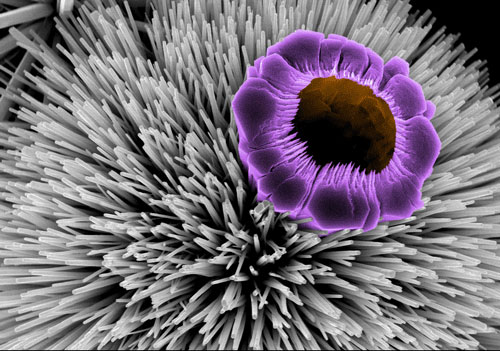 |
| Nano flower. Nano Flower made of zinc oxide, Scanning electron microscope image of zinc oxide nanowire arrays with flower-like form. (Hyun Wook Kang)
|
|
|
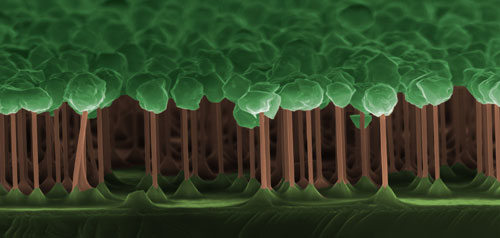 |
| The dark forest of GaAs/GaInP nanowires. Looking into the dark forest of GaAs/GaInP nanowires imaged by SEM. The nanowires were grown in two steps: first the GaAs stem using a Au particle as seed particle in MOVPE. The sample was removed from the reactor and a layer of HSQ resist was applied by spinning, forming a thin layer of moss. When the GaInP was grown during a second MOVPE step, the resist prevented growth on the substrate and sidewalls of the GaAs stems. The image is artificially colorized, but based on EDS measurements; light green represents GaInP and light brown/red GaAs. The substrate and base of GaAs nanowires has a dark green color to represent the areas where thicker resist was detected. (Daniel Jacobsson, Lund University)
|
|
|
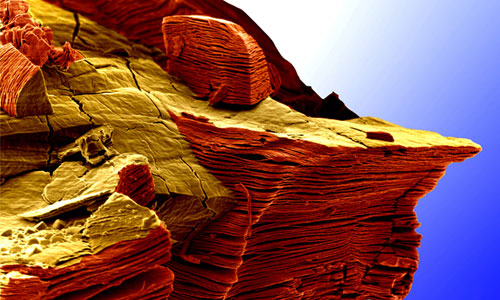 |
| The cliff of the two-dimensional world.When the layered ternary compound, Ti3AlC2, is placed in hydrofluoric acid, the Al layers are selectively etched away resulting in two dimensional (2-D) layers of Ti3C2 weakly bonded to each other. The image shows a number of these particles, where exfoliation is obvious. Like graphene, individual layers can be isolated and their properties explored. Since Ti3AlC2 is a member of a large family of layered solids called MAX phases ? that number over 60 ? and given the similarities with graphene, we are calling this new family of 2-D solids "MXene." This image was chosen to represent a new frontier ? that is only visible from the cliff ? in the world of 2-D materials that will indubitably play an important role in the future. (Babak Anasori, Michael Naguib, Yury Gogotsi, Michel W. Barsoum)
|
|
We have a collection of these amazing images in some of our articles on Nanowerk. You can find the links here.
|







